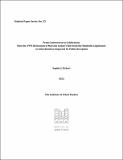From Controversy to Celebration: How the 1995 Relocation of Marcien Lemay's Riel from the Manitoba Legislature to Saint Boniface Impacted Its Public Reception
Metadata
Show full item recordAuthor
Sickert, Sophie J.
Date
2022-06Citation
Sickert, Sophie J. From Controversy to Celebration: How the 1995 Relocation of Marcien Lemay's Riel from the Manitoba Legislature to Saint Boniface Impacted Its Public Reception (Institute of Urban Studies Student Paper Series, no. 35). Winnipeg, Manitoba, Canada: The Institute of Urban Studies, University of Winnipeg, 2022. ISBN: 978-1-894858-22-9. DOI: 10.36939/ir.202206071325.
Abstract
In 1970, when the Manitoba government commissioned a statue of Louis Riel, one of Canada’s most significant (and most contentious) historical figures, the public expected a certain level of controversy. Commemorating an Indigenous francophone leader who was executed in 1885 for rebelling against the Canadian government was bound to elicit a certain level of resistance. Few, however, anticipated that the memorial would remain a topic of intense debate for the next 25 years. Yet, after 1995 when the statue was moved approximately 2.5 km from the Manitoba legislative grounds to the neighbourhood of Saint Boniface, the controversy all but disappeared. The question therefore arises: Why was the statue seen as objectionable in its first location, but as a successful commemorative project in its second? I argue that the statue’s relocation effectively changed how it was perceived by the public. This was achieved through a combination of changes to the statue’s environment, such as primary audience, physical surroundings and context markers, and an evolution of how Riel was remembered over time.

